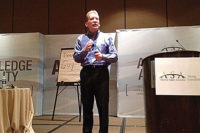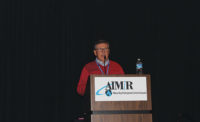
ASA Young Executives Vice Chairman Jeff Worly (left) of Worly Plumbing
Supply fields a question from Anthony Huey of RMA during a role-playing session
in New Orleans.
Photo by Bob Miodonski/Supply House Times
Faced with tough questions from a TV reporter, four actions you should avoid are:
1)Making a stupid facial expression;
2)Trying to end the interview;
3)Staring into the camera like a deer in the headlights; and
4)Declaring, “No comment!”
“It is never acceptable to say, ‘No comment!’” said consultantAnthony Hueyof Reputation Management Associates during his two-day workshop, “Communicating with Power,” at the spring meeting of the ASA Young ExecutivesMay 21-22 in New Orleans. The meeting drew about 85 attendees.
“Never lie,” he added. “You will always get in trouble for the cover-up. Never get angry or frustrated.”
Similar rules apply when you’re approached by an unhappy employee, customer or vendor. Here’s what you can do:
“Stay in control when questions get nasty and say what you want to say,” Huey said. “Go into all question-and-answer sessions with an agenda. Always get a positive message in.”
Like the Boy Scouts, Huey said his motto is, “Be prepared.” You can reach the same objective using one of these four techniques:
1)Nuggets, which he described as rehearsed ad libs. “Ask yourself the questions you always get asked and write down the answers in a Word document in advance,” Huey said. “Use them when you’re being asked difficult questions. For most questions, you’ll have 30, 45 or 60 seconds to respond. In TV news interviews, you’ll get 8 to 12 seconds.”
2)Bridging, which gets you from a topic you don’t want to talk about to one you do. Examples of good bridges are: “But I can tell you this …”; “First of all, let’s consider the big picture …”; and “But the facts are ...”
3)Bump and run, which allows you to answer the question and then gets you to what you want to say. Examples include: “Yes, but …”; “No, however …”; “It’s highly unlikely, however …”; and “It’s too soon to tell.”
4)Turn the tables, where you pose a question to the other person and then answer it yourself.
“The formula you use is, first, consider whether you want to answer the question,” Huey said. “If you don’t, then address the question. The goal is not always to answer the question but you need to respond to the question. Then use a technique such as bridging or bump and run. Say whatever you want to say, which is your agenda.”
Being prepared applies to public speaking as well, he said. Before making a speech, the three areas of preparation are practice, practice and practice.
“The minimum for a new presentation is 10 times out loud,” Huey said. “After 10 times, you’ll have your speech 80% memorized and then you can condense it to bullet points to remind your memory when you give your talk.”
Other public speaking tips include: use your smartphone to make a video of your speech rehearsal; ask for a critique from someone in your office or your spouse; use notes and type them double-spaced in 16-point font so you can read them if you move around the podium; number your pages in case they get mixed up; make sure water is in your reach; and don’t wear anything distracting.
“The key as a presenter is to have a conversation with your audience,” Huey said, “not to make a speech.”



